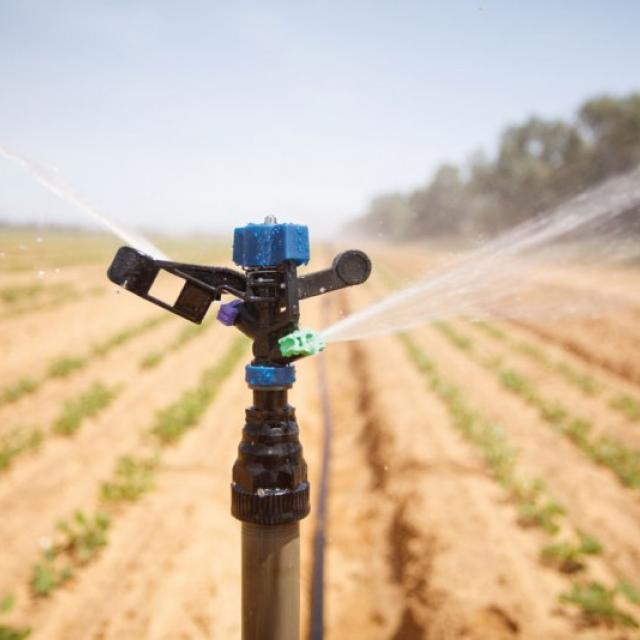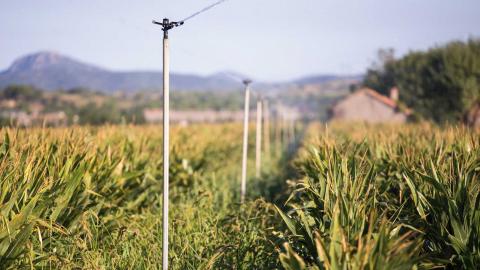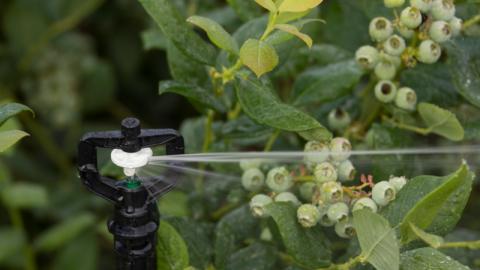Full-coverage sprinkler irrigation is the oldest pressurised irrigation technique. This method is still very popular and it is still used in installations where drip irrigation is not possible, whereas pivots are used as permanent systems on large fields.

They are found in all types of application: market gardening, fruit trees, cereals, mines, quarries. although, of course, the expectations will differ between a tree grower and a radish producer, for example. Full coverage can be successfully used with impact sprinklers or Mini-sprinklers. The system must be adapted to the crop, its environment and the user’s level of technical know-how. Three important parameters should be taken into consideration, which will have differing results depending on the applications. The most well-known and yet often neglected is “irrigation water distribution”. Market gardeners will be more interested in this aspect. “The droplet size” not only affects market gardeners, but also tree growers who are ever mindful of the exchange of gases between the soil and the atmosphere, soil compaction, etc… The last aspect, and possible the most recent, is that of the “flexibility” of the system.
Irrigation water distribution
For some crops, irrigation water distribution is a parameter that should not be ignored. With market gardening applications, for example, even more so when dealing with seed crops, it is no longer possible to just rely on choosing a sprinkler on the basis of its radius of throw. Sizing the system on the basis of the length of throw allows the user to ensure that there will not be any dry patches, but it does not in any way guarantee good uniformity of irrigation water distribution. In fact, the type and form of the spray needs to be considered and this can vary, depending on the operating pressure, nozzle type, spray angle, type of spray head, etc.
For this, it is important to define the needs very clearly and rely on the recommendations of the best manufacturers who have the software tools required when choosing the optimum configuration in accordance with the needs of the producer.
Apart from the choice of sprinkler, the design of the system should also be taken into consideration. A poorly sized installation can have significant variations in pressure in different parts of the field and, therefore, this could have an impact on the change of flow rate, which will require an over-watering of the wetter zones in order to apply the required dose on the drier zones. These variations will have a direct impact on the harvests, as well as the efficiency of any products that possibly may be injected into the system. The photo page 11, taken in 2015, shows a crop of carrots irrigated by the full coverage system, providing a clear illustration of the effect that a poor distribution of the irrigation water could have on yields.
Droplet size/precipitation rate
From an economic and practical point of view, we could assume that a full coverage system should have the widest possible spacing pattern such as 18 m x 18 m for example. These systems use sprinklers with very high flow rates and large droplet sizes, with enough inertia to cover such distances. However, in these cases, we could have an imbalance between the volume of water applied and the soil’s capacity to absorb this volume. This would thus result in significant soil compaction and a surplus of water, which would run off, leading to the ponding of water on flat land and erosion on slopes (particularly in orchards).
By contrast, in the case of sprinklers with finer droplets and a lower precipitation rate, the application of the irrigation water would be more gradual and we would see better penetration of the water into the soil and less wastage (through evaporation or the water filtrating too deeply into the soil).
Advantages of the gradual application of water with fine droplets
• Better penetration of the water into the soil. Less run-off.
• Reduces soil compaction.
• Reduces the leaching of nutrients and other inputs.
• Helps germination (we have observed that, after six weeks, with low flow sprinklers and fine droplet sizes, a crop is one week ahead in terms of maturity and germination compared with using the traditional impact sprinklers).
• Possibility of returning to the field sooner with the machinery (less over-irrigated areas or accumulated water).
• Better soil preparation prior to sowing or planting.
• Improved efficiency of injected products.
Flexibility
Apart from the sprinklers, the modifications also relate to the type of nozzle. All the old systems were installed with galvanised or aluminium pipes. The latest systems are generally made of 6m or 9m lengths of PE or even PVC, depending on the region. There are also flexible pipes, available with the relevant machinery thus facilitating the laying-out and retrieval of the system and considerably reducing the time and expense of transporting and storing the pipes.
By way of comparison, 1 Ha of full coverage irrigation equipment using flexible pipes can be laid from the coiling devices attached to the back of a vehicle, while one hectare of full coverage irrigation using 6 m pipes requires a tractor and trailer. This point must be taken into consideration when dealing with outlying fields.
This method is also well adapted to small-scale market gardening, which requires a system that is flexible and easily adaptable to different applications.
Conclusion
The agricultural industry continues to change and adapt so that it can remain competitive and efficient. We come across more and producers who are very technically minded and aware that, beyond a certain level, there is scope for improvements to be made by making small adjustments to the parameters. Furthermore, certain improvements can be made to supplement certain efforts being made in other areas: you can use the best seeds in the world but you will not reap any benefit if your seed drill is not working properly. You will not fully benefit from your seed drill if your irrigation is only average and you will not benefit properly from fertilisers if they are leached or if there is erosion. It is a matter of maximising the advantages of the different components of a production system and looking at the way you approach irrigation if you are to succeed in this respect.


